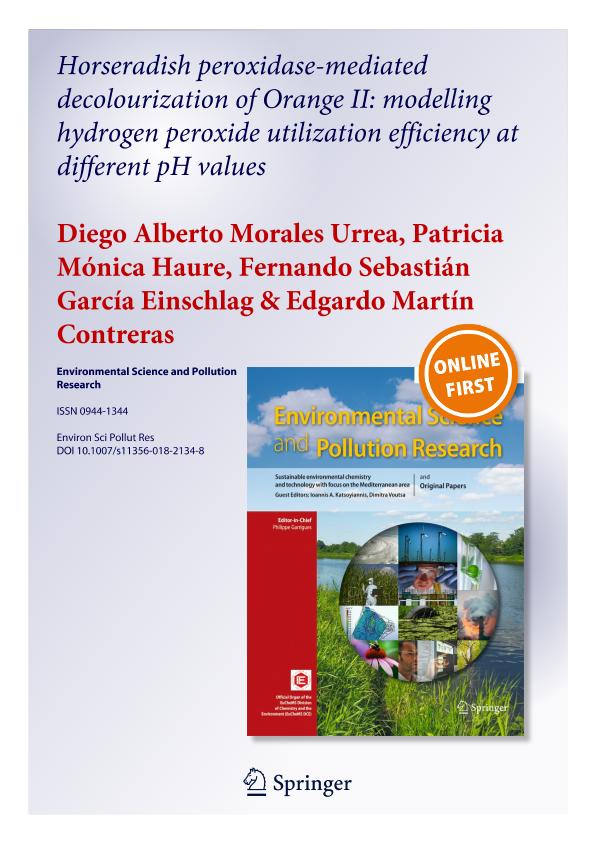Mostrar el registro sencillo del ítem
dc.contributor.author
Morales Urrea, Diego Alberto

dc.contributor.author
Haure, Patricia Monica

dc.contributor.author
Garcia Einschlag, Fernando Sebastian

dc.contributor.author
Contreras, Edgardo Martin

dc.date.available
2019-12-09T19:02:28Z
dc.date.issued
2018-05-09
dc.identifier.citation
Morales Urrea, Diego Alberto; Haure, Patricia Monica; Garcia Einschlag, Fernando Sebastian; Contreras, Edgardo Martin; Horseradish peroxidase-mediated decolourization of Orange II: modelling hydrogen peroxide utilization efficiency at different pH values; Springer Heidelberg; Environmental Science and Pollution Research; 25; 20; 9-5-2018; 19989-20002
dc.identifier.issn
0944-1344
dc.identifier.uri
http://hdl.handle.net/11336/91760
dc.description.abstract
Enzymatic decolourization of azo-dyes could be a cost-competitive alternative compared to physicochemical or microbiological methods. Stoichiometric and kinetic features of peroxidase-mediated decolourization of azo-dyes by hydrogen peroxide (P) are central for designing purposes. In this work, a modified version of the Dunford mechanism of peroxidases was developed. The proposed model takes into account the inhibition of peroxidases by high concentrations of P, the substrate-dependant catalatic activity of peroxidases (e.g. the decomposition of P to water and oxygen), the generation of oxidation products (OP) and the effect of pH on the decolourization kinetics of the azo-dye Orange II (OII). To obtain the parameters of the proposed model, two series of experiments were performed. In the first set, the effects of initial P concentration (0.01–0.12 mM) and pH (5–10) on the decolourization degree were studied at a constant initial OII concentration (0.045 mM). Obtained results showed that at pH 9–10 and low initial P concentrations, the consumption of P was mainly to oxidize OII. From the proposed model, an expression for the decolourization degree was obtained. In the second set of experiments, the effect of the initial concentrations of OII (0.023–0.090 mM), P (0.02–4.7 mM), HRP (34–136 mg/L) and pH (5–10) on the initial specific decolourization rate (q 0 ) was studied. As a general rule, a noticeable increase in q 0 was observed for pHs higher than 7. For a given pH, q 0 increased as a function of the initial OII concentration. Besides, there was an inhibitory effect of high P concentrations on q 0 . To asses the possibility of reusing the enzyme, repeated additions of OII and P were performed. Results showed that the enzyme remained active after six reuse cycles. A satisfactory accordance between the change of the absorbance during these experiments and absorbances calculated using the proposed model was obtained. Considering that this set of data was not used during the fitting procedure of the model, the agreement between predicted and experimental absorbances provides a powerful validation of the model developed in the present work.
dc.format
application/pdf
dc.language.iso
eng
dc.publisher
Springer Heidelberg

dc.rights
info:eu-repo/semantics/openAccess
dc.rights.uri
https://creativecommons.org/licenses/by-nc-sa/2.5/ar/
dc.subject
Horseradish peroxidase
dc.subject
Orange II
dc.subject
Hydrogen peroxide
dc.subject
Kinetic model
dc.subject
Horseradish peroxidase
dc.subject
Orange II
dc.subject.classification
Bioprocesamiento Tecnológico, Biocatálisis, Fermentación

dc.subject.classification
Biotecnología Industrial

dc.subject.classification
INGENIERÍAS Y TECNOLOGÍAS

dc.subject.classification
Ingeniería de los Materiales

dc.subject.classification
Ingeniería de los Materiales

dc.subject.classification
INGENIERÍAS Y TECNOLOGÍAS

dc.title
Horseradish peroxidase-mediated decolourization of Orange II: modelling hydrogen peroxide utilization efficiency at different pH values
dc.type
info:eu-repo/semantics/article
dc.type
info:ar-repo/semantics/artículo
dc.type
info:eu-repo/semantics/publishedVersion
dc.date.updated
2019-10-22T15:41:03Z
dc.journal.volume
25
dc.journal.number
20
dc.journal.pagination
19989-20002
dc.journal.pais
Alemania

dc.journal.ciudad
Heidelberg
dc.description.fil
Fil: Morales Urrea, Diego Alberto. Consejo Nacional de Investigaciones Científicas y Técnicas. Centro Científico Tecnológico Conicet - Mar del Plata. Instituto de Investigaciones en Ciencia y Tecnología de Materiales. Universidad Nacional de Mar del Plata. Facultad de Ingeniería. Instituto de Investigaciones en Ciencia y Tecnología de Materiales; Argentina
dc.description.fil
Fil: Haure, Patricia Monica. Consejo Nacional de Investigaciones Científicas y Técnicas. Centro Científico Tecnológico Conicet - Mar del Plata. Instituto de Investigaciones en Ciencia y Tecnología de Materiales. Universidad Nacional de Mar del Plata. Facultad de Ingeniería. Instituto de Investigaciones en Ciencia y Tecnología de Materiales; Argentina
dc.description.fil
Fil: Garcia Einschlag, Fernando Sebastian. Consejo Nacional de Investigaciones Científicas y Técnicas. Centro Científico Tecnológico Conicet - La Plata. Instituto de Investigaciones Fisicoquímicas Teóricas y Aplicadas. Universidad Nacional de La Plata. Facultad de Ciencias Exactas. Instituto de Investigaciones Fisicoquímicas Teóricas y Aplicadas; Argentina
dc.description.fil
Fil: Contreras, Edgardo Martin. Consejo Nacional de Investigaciones Científicas y Técnicas. Centro Científico Tecnológico Conicet - Mar del Plata. Instituto de Investigaciones en Ciencia y Tecnología de Materiales. Universidad Nacional de Mar del Plata. Facultad de Ingeniería. Instituto de Investigaciones en Ciencia y Tecnología de Materiales; Argentina
dc.journal.title
Environmental Science and Pollution Research

dc.relation.alternativeid
info:eu-repo/semantics/altIdentifier/url/http://link.springer.com/10.1007/s11356-018-2134-8
dc.relation.alternativeid
info:eu-repo/semantics/altIdentifier/doi/http://dx.doi.org/10.1007/s11356-018-2134-8
Archivos asociados
